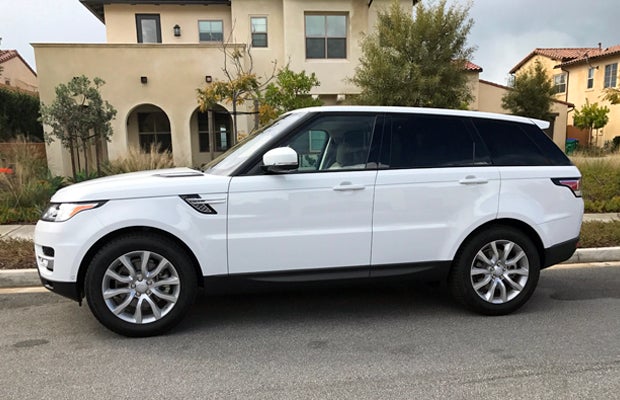
The Range Rover Sport delivers on the SUV promise as few can. It rides, handles, and accelerates like a luxury sedan. It is capable of leaving the pavement and hauls like, well, an SUV. Rear seat access is first-rate, headroom is generous, visibility is good, and NVH is all but non-existent. Fuel economy is even acceptable. The engineers, marketers, and finance people at JLR appear to have composed this vehicle without uncompromise. But their resolute pursuit of luxury combined with utility did come at a cost. The Range Rover Sport starts at $65,650 and this HSE tester, near the bottom of the Range Rover Sport range, stickers at $69,995 plus a $995 destination charge.
Land Rover introduced the Range Rover Sport, its penultimate nameplate, in 2005. It looked like a three-quarter size Range Rover but was in fact an LR4 derivative, employing the lesser modelís integrated body-on-frame semi-monocoque platform. The first-generation Sport averaged 14,200 annual sales in the United States, enough to support the development of an all-new version, which bowed in 2014. The second generation dropped 400 pounds, gained seven inches between the wheels, and added three inches overall. It also moved to an all-aluminum monocoque body akin to the full-size Range Rover.
The 2014 update, combined with the economic recovery and low fuel prices, contributed to sales gains in five of the last six years. In 2016 JLR sold 21,600 Range Rover Sports in the U.S. plus 3,200 in Canada, besting the similarly sized and priced Cayenne by 40 percent, though tallying just half of BMW X5 sales.
The big news for 2016 is the addition of a turbo diesel delivering 443 lb.-ft. of torque and 25 mpg combined. Other updates include higher definition cameras, off-road crawl-control, self-lowering suspension, and several previously optional features have become standard. The Range Rover Sport comes in SE, HSE, HSE Dynamic, Supercharged, Autobiography, and SVR trims.
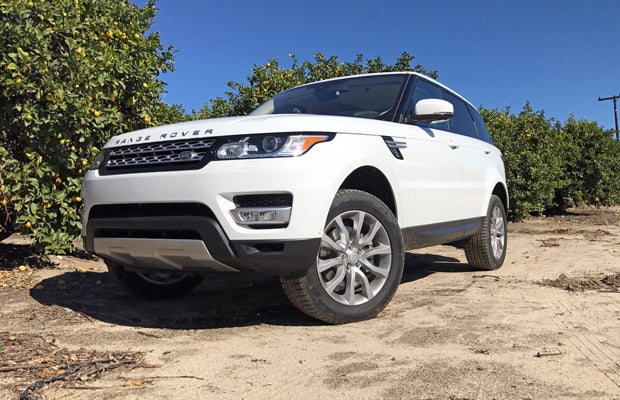
Exterior
The Range Rover Sport continues to channel the Range Rover design language. Straight lines with rounded corners conceal a vehicle just six inches shorter than its big brother, but its equal in width. The Sport looks sharp capped in white above an all-black greenhouse, with the lower body in white. Its gently tapered roofline and raked rear window contribute to a sporting appearance but do not impede rear seat access, nor do they materially limit cargo space or visibility.
The HSE comes standard with 20-inch alloys, up an inch in diameter from the SE. Both trims come with xenon headlights surrounded by signature LEDs. And for trim spotters, the HSE gets narrow fog lights mounted low and outboard in the fascia. A self-leveling air suspension with auto access height is standard across the range, as are front and rear parking sensors, power folding mirrors, and a hands-free power lift gate. Cameras ring the perimeter, which can be called up any time in a variety of configurations. The front quarter views can be helpful when off-piste.
You can also lock and unlock your Range Rover Sport, reset the alarm, sound the horn, and flash the lights from your phone with InControl Protect. Itís a great feature when you get turned around in the Whole Foods parking lot and arenít sure which Range is yours.
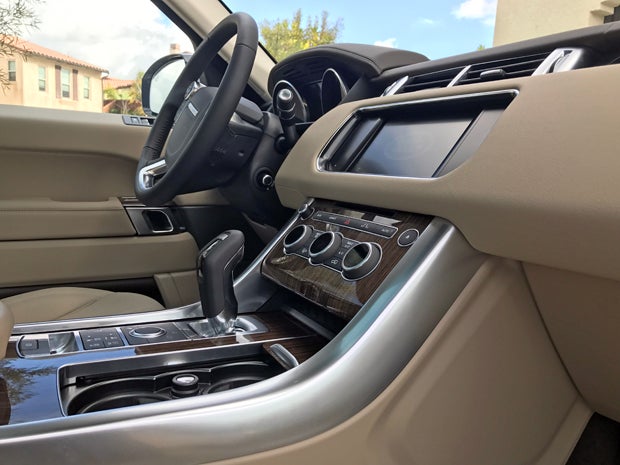
Interior
Much like the exterior, the interior spurns gimmickry in favor of straightforward styling. There are no freeform shapes or swooping lines, as in an Infinity QX80. Nor are there boldly sculpted vent bezels or rich color mixtures as in a Porsche Cayenne. These design aesthetics have their place, but this Range Rover turns toward convention, rather than away from it. It achieves distinction and elegance with familiar forms punctuated by high-quality materials and meticulous execution.
Buttons and switches look as good as they feel and are logically labeled and organized. I particularly appreciate the subtle, real estate saving readouts at the center of each HVAC dial. However, the haptic controls bracing the main screen in the center stack could be larger and easier to select when under way. Moreover, the 8.0-inch touchscreen feels undersized and the infotainment system dated.
Materials, fit, and finish are peer competitive. Unfortunately, Land Rover got on the alternative gear selector bus with FCA, BMW, and others. And although their solution is preferable to that found in the Grand Cherokee, it is still creative where ordinary is preferable. Letís get back to the good old P-R-N-D-L with positive detents between each.
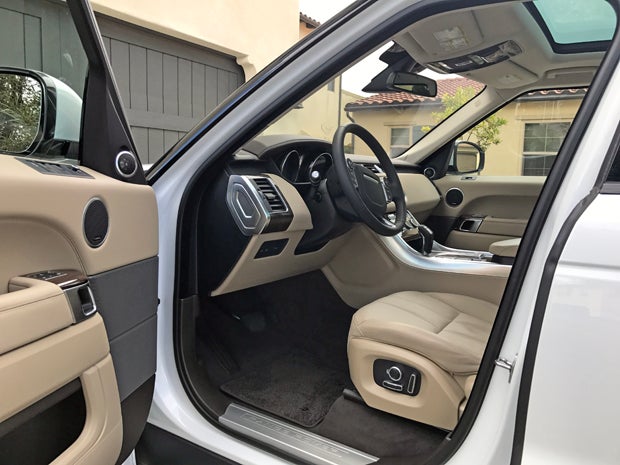
Inside are 14-way power heated and ventilated front seats and dual-zone climate control. The driver gets memory settings, a power-adjustable steering wheel, and an auto-dimming rearview mirror. In back is a 60/40-split folding seat and an optional child-only third row. The HSE gets perforated leather upholstery and upgraded trim.
A fixed panoramic roof with power shade is standard on HSE. This portal to the universe extends from above the driver and front passenger to well behind the second row passengers, without any crossbars or other interruptions. The standard HSE glass roof provides a real wow factor versus the optional dual pane roof that transitions to standard equipment on the Supercharged V8 trim.
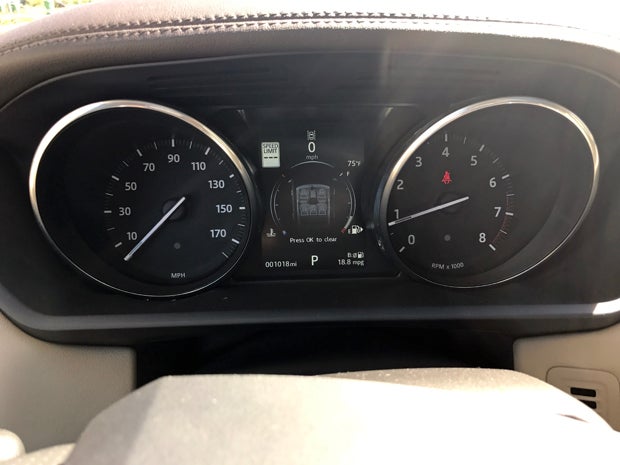
If the brief provided by the product planners called for a classy, understated, functional interior, with a hint of Range Rover heritage, they nailed it.
On-Road
The Range Rover Sport makes one forget they are driving an SUV. It steps out with ease under moderate throttle, corners with flat composure, and stops with poise. It shrugs off road imperfections, reducing them from a nuisance to an afterthought. Steering is well weighted and liner, if somewhat detached. The HUD (Head-Up Display) is a welcome companion, though it is obscured in certain lighting conditions. And of course the driving position will not be confused with that of a car. But when parked, the vehicle automatically ducks to Access height, making entry and exit more car-like.
The 3.0-liter V6 delivers 340 horsepower at 6,500 rpm and 332 lb.-ft. of torque at 3,500 rpm. It is mated to a conventional eight-speed automatic with a manual shift mode. On paper, power delivery looks car-like, but its immediacy is a reminder of the benefit of supercharging over turbocharging. The 3.0 motivates this 4,660 lb. rig to 60 miles per hour in 6.9 seconds. This does not feel like an entry-level engine. It can also tow 7,700 lbs. And the EPA rates fuel economy at 19 city, 23 highway. Observed fuel economy over a highway/freeway intense 600 mile test cycle was 18.9 mpg, a significant 3.0 mpg better than a 3.5L turbocharged Ford Explorer Platinum I recently tested.
The Range Rover Sport does not pull its driver toward canyon roads, but it can hustle through one without drama. A true sport sedan alternative it is not, but it makes an impressive luxury sedan substitute. Think of it as a BMW 530 alternative. If you are looking for a BMW 540 stand-in, Land Rover will sell you a supercharged 510 to 550 horsepower V8 powered Range Rover Sport.
Off-Road
All but gone are the days of wheeling with a simple two-speed transfer case. Even todayís mainstream SUVs have multi-mode terrain response systems, hill descent control, as well as other traction enhancing features. As a premium SUV, the Range Rover Sport must push the traction frontier with ever more sophisticated technologies.
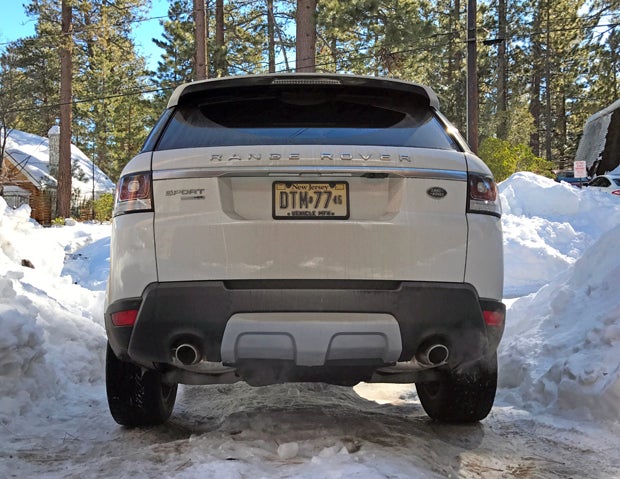
Full-Time Four Wheel Drive with Electronic Traction Control (4ETC) and Terrain Response are standard. Terrain Response, which is found in many Land Rovers, offers five settings (Sand, Rock Crawl, Grass/Gravel/Snow, Mud Ruts, and General) using a retractable rotary knob immediately aft of the shifter. The settings remap a variety of vehicle settings including throttle response, shift timing, and Hill Descent Control. Moving to a V8 brings a two-speed transfer case and Terrain Response 2, which can detect the road surface automatically and optimize vehicle settings without driver intervention.
This SUV also has 4-corner Electronic Cross Linked Air Suspension with four height settings (Access, Normal, Intermediate Off-Road, and Extended). Access lowers the vehicle almost an inch from Normal. Off-Road elevates the vehicle 1.4 inches above Normal and Extended moves it up another 1.2 inches for a total of 10.9 inches of ground clearance. If you are off-road and the vehicle bottoms out, it will activate Reactive Grounding Response, raising the vehicle to prevent damage and/or high-centering. The Range Rover Sport will also babysit you if you are off-road on a downward slope and do not have Hill Descent Control engaged - Gradient Acceleration Control will brake on your behalf.
Land Rover has automated the off-road experience. If you are a novice this makes traction challenging situations less intimidating, such as for the LA driver who goes skiing a couple times a year. For the veteran, these systems may feel unnecessary. Regardless, they make leaving the pavement a simple, confidence inspiring activity. Driving this Range Rover Sport over more than 50 miles of compact snow and ice was alarmingly easy. The Grass/Gravel/Snow mode all but eradicated wheel spin. Directional control was thoroughly predictable. My 20 year-old self would have hated it. Now with kids and a wife prone to bouts of road condition anxiety, it is remarkable.
The Range Rover Sport was equally unflappable in deeply rutted muddy conditions that were more challenging than most owners will attempt. Finding the off-road limits of this vehicle would require steely nerves and a waiver from Land Rover. I had neither. However, if you are a capabilities denier, consider how Land Rover has designed a competitive SUV for an on-road biased market without eviscerating its core off-road attributes. Its approach angle is 33 degrees and its departure angle is 31 degrees. This compares to 22 and 20 degrees for a BMW X5 and 29 and 26 degrees for an air suspended Porsche Cayenne at full height.
The Range Rover Sport has no fewer than six systems directly related to off-road operation. If you want to get the most out of yours off-pavement, reading the ownerís manual, watching instructional YouTube videos, and figuring it out on the fly would be a pleasure but may not produce the best results. You need training, such as that offered by one of four Land Rover Experience Centers across North America.
Conclusion
At $70,000, the market is thick with high-quality competitors offering a compelling mix of car-like driving dynamics, world-class luxury, and brand exclusivity. But few provide adventure-ready capabilities like this vehicle. Trite but true, the Range Rover Sport offers a genuinely unique value proposition. But donít buy one because itís best in class off-road. Buy one because you revere the Range Rover heritage, you appreciate its straight forward approach to design, or because you just love how it feels.


 Your Privacy Choices
Your Privacy Choices